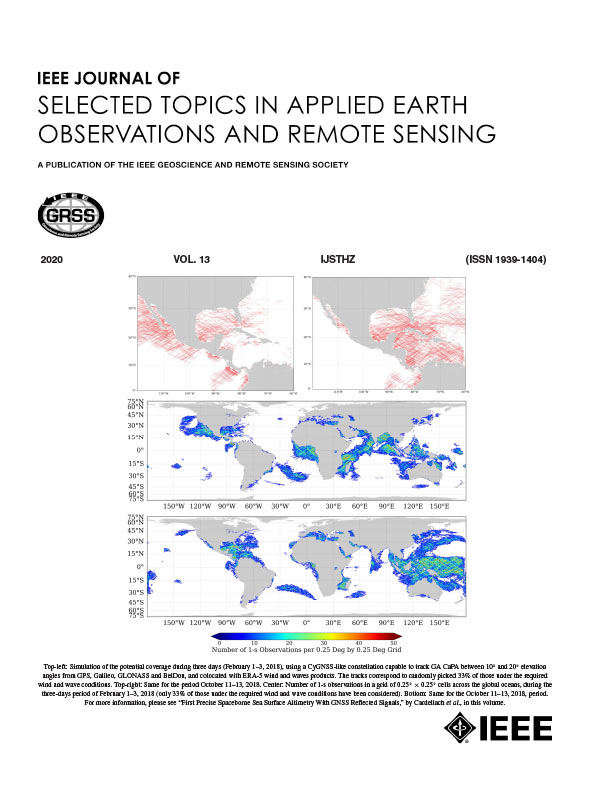Background Debiased SAR Automatic Target Recognition via a Novel Causal Interventional Regularizer
IF 4.7
2区 地球科学
Q1 ENGINEERING, ELECTRICAL & ELECTRONIC
IEEE Journal of Selected Topics in Applied Earth Observations and Remote Sensing
Pub Date : 2024-09-12
DOI:10.1109/JSTARS.2024.3459869
引用次数: 0
Abstract
Recent studies have utilized deep learning (DL) techniques to automatically extract features from synthetic aperture radar (SAR) images, which shows great promise for enhancing the performance of SAR automatic target recognition (ATR). However, our research reveals a previously overlooked issue: SAR images to be recognized include not only the foreground (i.e., the target), but also a certain size of the background area. When a DL-model is trained exclusively on foreground data, its recognition performance is significantly superior to a model trained on original data that includes both foreground and background. This suggests that the presence of background impedes the ability of the DL-model to learn additional semantic information about the target. To address this issue, we construct a structural causal model (SCM) that incorporates the background as a confounder. Based on the constructed SCM, we propose a causal intervention-based regularization method to eliminate the negative impact of background on feature semantic learning and achieve background debiased SAR-ATR. The proposed causal interventional regularizer can be integrated into any existing DL-based SAR-ATR models, mitigating the impact of background interference on the feature extraction and recognition accuracy without affecting the testing speed of these models. Experimental results on the moving and stationary target acquisition and recognition and SAR-AIRcraft-1.0 datasets indicate that the proposed method can enhance the efficiency of existing DL-based methods in a plug-and-play manner.通过新型因果干预正则化器实现去背景化合成孔径雷达自动目标识别
最近的研究利用深度学习(DL)技术从合成孔径雷达(SAR)图像中自动提取特征,这为提高合成孔径雷达自动目标识别(ATR)性能带来了巨大希望。然而,我们的研究发现了一个以前被忽视的问题:需要识别的 SAR 图像不仅包括前景(即目标),还包括一定大小的背景区域。当 DL 模型只在前景数据上进行训练时,其识别性能明显优于在包含前景和背景的原始数据上训练的模型。这表明,背景的存在阻碍了 DL 模型学习目标额外语义信息的能力。为了解决这个问题,我们构建了一个结构因果模型(SCM),将背景作为混杂因素纳入其中。基于所构建的 SCM,我们提出了一种基于因果干预的正则化方法,以消除背景对特征语义学习的负面影响,实现去背景化的 SAR-ATR。所提出的因果干预正则化方法可以集成到任何现有的基于 DL 的 SAR-ATR 模型中,在不影响这些模型测试速度的情况下,减轻背景干扰对特征提取和识别准确性的影响。在移动和静止目标获取与识别以及 SAR-AIRcraft-1.0 数据集上的实验结果表明,所提出的方法能以即插即用的方式提高现有基于 DL 方法的效率。
本文章由计算机程序翻译,如有差异,请以英文原文为准。
求助全文
约1分钟内获得全文
求助全文
来源期刊
CiteScore
9.30
自引率
10.90%
发文量
563
审稿时长
4.7 months
期刊介绍:
The IEEE Journal of Selected Topics in Applied Earth Observations and Remote Sensing addresses the growing field of applications in Earth observations and remote sensing, and also provides a venue for the rapidly expanding special issues that are being sponsored by the IEEE Geosciences and Remote Sensing Society. The journal draws upon the experience of the highly successful “IEEE Transactions on Geoscience and Remote Sensing” and provide a complementary medium for the wide range of topics in applied earth observations. The ‘Applications’ areas encompasses the societal benefit areas of the Global Earth Observations Systems of Systems (GEOSS) program. Through deliberations over two years, ministers from 50 countries agreed to identify nine areas where Earth observation could positively impact the quality of life and health of their respective countries. Some of these are areas not traditionally addressed in the IEEE context. These include biodiversity, health and climate. Yet it is the skill sets of IEEE members, in areas such as observations, communications, computers, signal processing, standards and ocean engineering, that form the technical underpinnings of GEOSS. Thus, the Journal attracts a broad range of interests that serves both present members in new ways and expands the IEEE visibility into new areas.

 求助内容:
求助内容: 应助结果提醒方式:
应助结果提醒方式:


